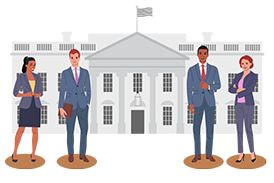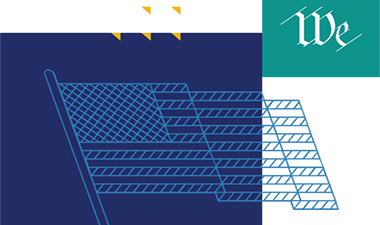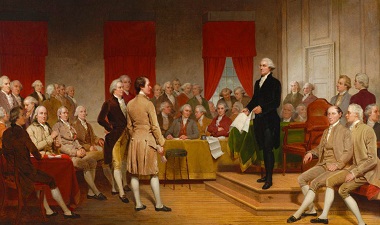
Getting Started
This module includes two Unboxing the Constitution videos (4 min and 5 min), an Inside the Constitution video (5 min), student activities, and a learning project. Download the Teachers Guide and the Student Content Guide for more details on content and implementation. Course materials are provided in Google documents, Word documents, as well as printable PDFs.
A preview of the module can be accessed below.
Topics covered include:
- Defining key terms
- Primary Sources and Article III
- Becoming a Supreme Court justice

Vocabulary
At the beginning of each module, students are presented with vocabulary words and definitions.
Concept Words
Concept words are conceptually related to the big ideas in what they’re learning. These connect directly to the core concepts or themes of the lesson or unit and help students grasp the main ideas and how everything fits together.
- advice and consent: the Senate’s power to approve or reject the president’s nominees, including to the Supreme Court
- concurring opinion: an opinion from a justice who agrees with the majority on who should win the case but offers some additional thoughts on how to think about the constitutional issue in the case
- dissenting opinion: an opinion in a case explaining why a justice disagrees with the majority opinion and why they would decide the case differently
- docket: the list of cases the Court will hear in a term
- judicial independence: the idea that the federal courts must be independent from the control of the other branches of government
- judicial review: the power to review the constitutionality of acts of the national and state governments
- judicial supremacy: the idea that the Supreme Court serves as the ultimate authority on interpreting the Constitution, and its decisions on constitutional matters are binding on all other branches of government and lower courts
- majority opinion: the official decision of the court in a case, supported by more than half of the justices, which explains the reasoning behind the ruling
- precedent: an earlier occurrence of something (for example, an earlier court decision)
- Writ of Certiorari: an order issued by the Supreme Court to a lower court to review the records of a case. It is granted when at least four of the nine justices agree to hear the case
Speed Bump Words
Speed bump words are words that aren’t central to the concept being taught, but if students don’t understand them, they may struggle to comprehend the text or lesson. These words can help shape students' overall understanding of the topic.
- controversial: subject to public discussion or argument
- nominate: to propose a candidate for office
- norm: something that is usual or standard
- vest: to grant authority

Topic 1: The Role and Responsibilities of the Judiciary
Article III of the United States Constitution establishes the judicial branch of the federal government and outlines the structure, powers, and responsibilities of the federal courts, including the Supreme Court, which is the highest court in the nation. Article III is actually very short and doesn’t spell out many details about the Supreme Court and how it works, or even what the judicial system should look like overall. One of the most important powers of the court, judicial review, isn’t explicitly mentioned in the Constitution. So, what is this power? And why does the Court have it?
9.1: Activate Prior Knowledge
To start engaging with the content in this module, students will collaboratively brainstorm words, phrases, and names that come to mind when looking at a picture of Supreme Court justices.
Unboxing the Constitution
In this Unboxing the Constitution video, Lucy explores key concepts related to Article III and landmark Supreme Court cases.
9.2: Article III Meaning Match
Students will review key terms related to Article III and the judiciary branch.
9.3: Unpacking Article III
Watch Inside the Constitution to learn more about Alexander Hamilton’s ideas about the judicial branch, then dive into Federalist No. 78 to gain even more insight.
9.4: Closing Activity
Students will check in on the Key Question(s).

Topic 2: The "Critical Period"
The highest court in the judicial branch is the U.S. Supreme Court, with one Chief Justice and eight Associate Justices deciding the most important cases. The federal judicial branch also includes the 94 district courts in states across the country, and 13 courts of appeals. The Supreme Court doesn’t hear every case that started in one of the district courts. So, how do certain cases get to the Supreme Court?
9.5: A Supreme Case
Students will watch Unboxing the Constitution - Video One to learn about the way the Supreme Court works, and how a case makes its way to the Supreme Court. Afterwards, students will dive deeper into the process by reading about the process and sharing ideas with their peers.
9.6: The Justices
How does someone become a Supreme Court Justice? In this activity, students will learn about the process, and how it has changed throughout history.
9.7: Civic Connection: How Do Justices Get Their Seats?
Every Supreme Court Justice has their own story of how they joined the bench. In this Civic Connection activity, students will pick a Justice–from today or from history–and learn more about their confirmation process.
9.8: Reflect
To end this module, students will revisit the brainstorming activity from the beginning of the module to see how insights have grown throughout the lesson.

Learning Project: Supreme Role Play
Judicial independence is equally critical, ensuring that the courts can make impartial decisions free from political pressure or influence. Together, judicial review and judicial independence ensure that the judicial branch fulfills its mandate of interpreting and upholding the Constitution while maintaining balance within the federal government. In this activity, students will engage with these foundational concepts by role-playing key Supreme Court cases to better understand how judicial review works in practice and how the Court navigates constitutional questions.













